Compton and Shawford
| Compton and Shawford | |
|---|---|
 Compton Street; primary school on right | |
Location within Hampshire | |
| Population | 1,420 [1] 1,729 (2011 Census)[2] |
| OS grid reference | SU470251 |
| Civil parish |
|
| District | |
| Shire county | |
| Region | |
| Country | England |
| Sovereign state | United Kingdom |
| Post town | Winchester |
| Postcode district | SO21 |
| Dialling code | 01962 |
| Police | Hampshire and Isle of Wight |
| Fire | Hampshire and Isle of Wight |
| Ambulance | South Central |
| UK Parliament | |
| Website | comptonshawford-pc |
Compton and Shawford is a civil parish in the City of Winchester district, immediately southwest of the city, in Hampshire, England. Its main settlements are the villages of Compton and Shawford.
Description
[edit]The word compton means village in a combe and aptly describes the settlement as it primarily consists of a long street on the side of a chalk valley.
Shawford is notable for having the longest railway viaduct in Hampshire (now known as Hockley Railway Viaduct). This is over 2,000 feet (610 m) in length and 40 feet (12 m) high. Disused since 1966, the viaduct was initially threatened with demolition when the M3 motorway was proposed but after much protest it was incorporated into the scheme.
The two halves of the parish are linked by Shawford Down which runs alongside the River Itchen. However they are now symbolically separated by the motorway with Compton on its west side and Shawford on its east.
Yew Hill is a prominence of elevation 121m above sea level situated approximately 1Km. North West of Compton[3] A covered reservoir fed by water pumped from Otterbourne water works is located here.[4][5][6] Silkstead Lane runs alongside Yew Hill.[7] A Butterfly Conservation area has been established at Yew Hill, 5.85 hectares (14.4 acres) in total size with open access to an area of 1.5 ha.[8]
Geology
[edit]The parish lies on the Upper Cretaceous chalk at the northern edge of the Hampshire Basin, dipping south from the Winchester anticline, with successively younger beds being exposed from north to south. In the north the Seaford Chalk formation of Santonian age makes up Compton Down. South of this the Newhaven Chalk outcrops in the dry valley running down from Oliver's Battery to Shawford. In the south of the parish the Culver Chalk of Campanian age is largely overlain by a layer of 'clay-with-flints' weathered out of the chalk. In the east the chalk is cut through by the Itchen valley and overlain by calcareous tufa.[9]
A feature of the geology is the hill immediately southwest of the village of Shawford known as Shawford Down. This area is noted for its rich variety of habitats and the grazed pasture supports a wealth of flora and fauna, including notable insects and wildflowers.[citation needed]
History
[edit]In the 1086 Domesday Book, Compton came under the manor of Chilcomb, but by 1250, was a separate manor, held by the Wasseling family. It was later held by the Philpot, Tichborne, and Heathcote families. The village had a mill on the river Itchen, which forms the parish boundary with Twyford.[10]
John Philpot of Compton was an early English martyr, executed in the reign of Queen Mary.[11]
Parish church
[edit]
All Saints' church in Compton dates in part from the 12th century. It is unusual in that it has two naves and two chancels, the original Norman constructions being supplemented by a new nave and chancel in 1905.[12] A bell-turret was added to the church in 1880.[13] The church's font appears to date from the Norman period.[13]
Amenities
[edit]National Cycle Route 23 passes through the parish,[14] as do bus services provided by Bluestar. The M3 motorway also goes through the parish, with junction 11 to the north and junction 12 to the south. Shawford railway station is served by stopping services on the South West Main Line.
The parish is crossed from east to west by the Monarch's Way long-distance footpath, and from north to south by the Itchen Way.
Compton is represented in the Hampshire Cricket League as one half of Compton & Chandlers Ford CC following the merging of Compton & Shawford CC and Chandlers Ford CC in 1995. The club plays its home games at the Memorial playing fields, just off of Shepards Lane.[15]
In media
[edit]Shawford was the location for Victor Meldrew's death the One Foot in the Grave episode "Things Aren't Simple Any More".[16][17] It is referred to in Robyn Hitchcock's song "Winchester".[18]
Shawford railway station was featured in a 1974 film starring Sophia Loren, a remake of Brief Encounter, as was Winchester station (though most filming took place at Brockenhurst). It caused great excitement in the village; a large crowd watched the actress being filmed getting out of a car on the forecourt.[citation needed]
Jon Tufnell, the leader of the band Plastic Toys, is a former resident of Compton and it was in his home studio in the village that he recorded the album For Tonight Only, which included the single "Let Me Feel The Love". It charted at Number 30 in the UK Indie Chart in 2007.[citation needed]
Nearby places
[edit]References
[edit]Notes
[edit]- ^ "Parish Headcounts, Area: Compton & Shawford CP". Neighbourhood Statistics. Office for National Statistics. 2001. Archived from the original on 12 June 2011. Retrieved 10 March 2008.
- ^ "Civil Parish population 2011". Neighbourhood Statistics. Office for National Statistics. Retrieved 13 December 2016.
- ^ "Location Map".
- ^ A Survey of Southampton and its Region, Ed. F.J Monkhouse. Chap.VII,p100.
- ^ "Geograph:: Water Reservoir on Yew Hill © Peter Facey cc-by-sa/2.0".
- ^ "26509_014 - Aerial Photo | Historic England".
- ^ "Geograph:: Silkstead Lane, Yew Hill © Jim Champion cc-by-sa/2.0".
- ^ "Yew Hill, Hampshire".
- ^ British Geological Survey (2002), Winchester. England and Wales Sheet 299. Solid and Drift Geology, 1:50,000 Series geological map, Keyworth, Nottingham: British Geological Survey, ISBN 0-7518-3340-1
- ^ "Parishes: Compton Pages 406-408 A History of the County of Hampshire: Volume 3". British History Online. Retrieved 8 August 2023.
- ^ "John Philpot, Compton's Martyr". Compton and Shawford Local History Society. 16 August 2017. Retrieved 8 August 2023.
- ^ Historic England. "Church of All Saints (1157101)". National Heritage List for England. Retrieved 4 March 2020.
- ^ a b O’Brien, Charles; Bailey, Bruce; Pevsner, Nikolaus; Lloyd, David W. (2018). The Buildings of England Hampshire: South. Yale University Press. pp. 229–230. ISBN 9780300225037.
- ^ "Route 23 - Map". Sustrans. Retrieved 30 October 2017.
- ^ Compton & Chandler's Ford CC
- ^ Banks, David (21 July 2000). "Village scene of Victor's demise" (Extract reproduced on unofficial website by permission of the Editor). Hampshire Chronicle. Retrieved 23 December 2016.
- ^ Webber 2006, p. 186
- ^ "Winchester Lyrics". www.rogerwatersonline.com. Retrieved 4 March 2020.
Bibliography
[edit]- Webber, Richard (2006). The Complete One Foot in the Grave. London: Orion. ISBN 978-0-7528-7357-2.
External links
[edit]![]() Media related to Compton and Shawford at Wikimedia Commons
Media related to Compton and Shawford at Wikimedia Commons




